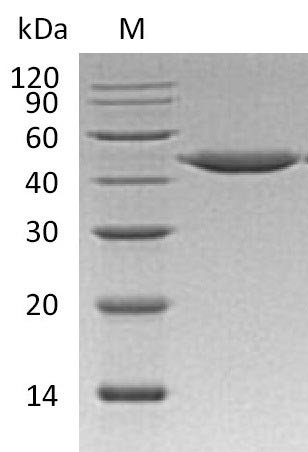Our Recombinant Human CTSE protein is an essential research tool for scientists in the field of cancer biology. Cathepsin E, also known as CTSE, is produced in mammalian cells and features the full-length expression region from 20-396aa. The protein is fused with a C-terminal 6xHis-tag for ease of purification and identification. The lyophilized powder format allows for straightforward reconstitution with sterile water or buffer to suit various experimental needs.
The Recombinant Human CTSE protein demonstrates high quality and performance with a purity greater than 95%, as determined by SDS-PAGE analysis. Additionally, endotoxin levels are maintained below 1.0 EU/µg, as assessed by the LAL method. The protein exhibits specific activity greater than 1500 pmol/min/ug, as determined by its ability to cleave the fluorogenic peptide substrate, Mca-PLGL-Dpa-AR-NH2, highlighting its functionality for relevant applications.
Human CTSE has been a subject of interest in numerous research studies due to its role in the degradation of intracellular proteins and its implications in cancer biology. Research conducted by Chain et al. (2005)[1] and Vidak et al. (2017)[2] contributed to a better understanding of the function and potential clinical applications of CTSE. These studies highlight the importance of CTSE in tumorigenesis, tumor progression, and its potential therapeutic value in cancer treatment.
References:
1. Chain BM, et al. The expression and function of cathepsin E in dendritic cells. J Immunol. 2005;174(4):1791-800.
2. Vidak E, et al. The role of cathepsin E in normal and pathological processes. Exp Biol Med (Maywood). 2017;242(10):1043-53.






